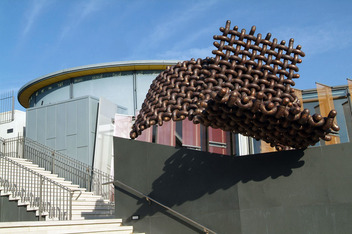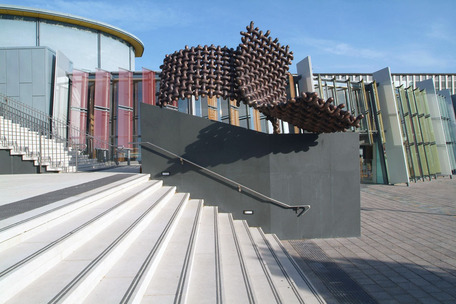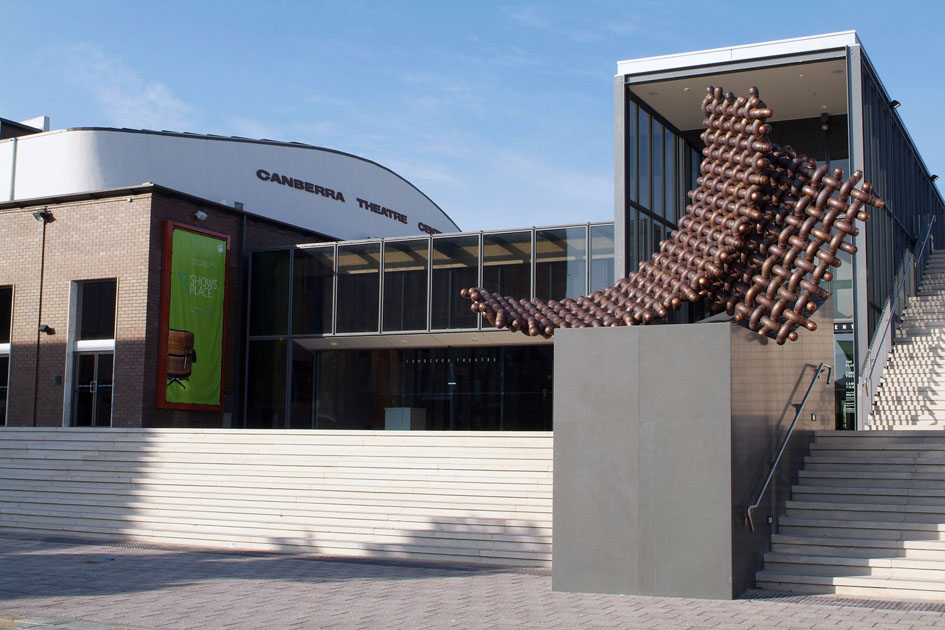
Fractal Weave, commissioned for the Civic Library and Link area of Canberra's Civic Square, Australian Capital Territory. The piece, comprised of two curved planes, is constructed or "woven" from 1000 X 100 mm copper elbow joints soldered together. The large curved woven mats are built over a radius of 2 meters; each approximately 2 meters wide and 5 meters long.
Civic Square is the home of both the ACT seat of government and cultural facilities including the library, theater, museum and art and craft galleries. Fractal Weave symbolically combines the social and cultural threads of Canberra into one interrelated and iconic sculpture which refers to dynamic relationships between the individual and their society.
J. E Cirlot defines the act of weaving in A Dictionary of Symbols as a metaphor for creation and life as it denotes accumulation and multiplication or growth. Fractal Weave at first glance appears as a woven structure but with further contemplation it provides a metaphorical window into the structure of a world of infinite dimension. The sculptural planes of the work have a curved profile as though they are fragments of larger cylindrical forms; potentially a fragment of a much larger weaving. This recalls David Bohm's idea of "implicate order" where information about the whole of a form is enfolded within its smallest fragment. Conceivably the individual copper elbows could also be made of a woven structure too small for us to see. In this way the work allows us to conceptually enter into a world of infinite dimension reminiscent of the fractal patterns of the Mandelbrot set defined by Chaos theory. This dynamic dimensional possibility implies the fabric of the work may expand to encompass the universe (a metaphor for society) or contract to a quantum particle (the individual).
Civic Square is the home of both the ACT seat of government and cultural facilities including the library, theater, museum and art and craft galleries. Fractal Weave symbolically combines the social and cultural threads of Canberra into one interrelated and iconic sculpture which refers to dynamic relationships between the individual and their society.
J. E Cirlot defines the act of weaving in A Dictionary of Symbols as a metaphor for creation and life as it denotes accumulation and multiplication or growth. Fractal Weave at first glance appears as a woven structure but with further contemplation it provides a metaphorical window into the structure of a world of infinite dimension. The sculptural planes of the work have a curved profile as though they are fragments of larger cylindrical forms; potentially a fragment of a much larger weaving. This recalls David Bohm's idea of "implicate order" where information about the whole of a form is enfolded within its smallest fragment. Conceivably the individual copper elbows could also be made of a woven structure too small for us to see. In this way the work allows us to conceptually enter into a world of infinite dimension reminiscent of the fractal patterns of the Mandelbrot set defined by Chaos theory. This dynamic dimensional possibility implies the fabric of the work may expand to encompass the universe (a metaphor for society) or contract to a quantum particle (the individual).

